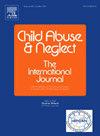揭露性侵犯后等待治疗的青少年的精神、自责和创伤症状。
IF 3.4
2区 心理学
Q1 FAMILY STUDIES
引用次数: 0
摘要
背景:遭受性虐待的青少年通常会经历创伤症状,许多人要花相当长的时间等待治疗。目的:本研究考察在筛选评估中收集的青少年对神圣精神支持、神圣精神斗争和自责的感知在治疗开始时预测创伤症状的程度。参与者和环境:参与者为224名青少年(92.9%为女性,平均年龄13.46岁;53.6%为西班牙裔/拉丁裔/黑人,24.1%为黑人/非裔美国人)。所有人都在美国南部的一个儿童倡导中心获得了服务。方法:青少年在筛选评估(T1)中报告创伤症状、神圣精神支持、神圣精神斗争和自责评价。创伤症状也在开始治疗时第二次报告(T2)。结果:在筛查评估时,总样本的创伤症状平均水平随时间下降,t(223) = 9.37, p 2 = 0.02),虐待自责(β = 0.11, t[219] = 2.03, p = 0.044, sr2 = 0.02)与治疗开始时较高的创伤症状水平相关,筛查评估时的性别、创伤症状和年龄受控制。结论:评估青少年对性虐待的神圣精神斗争和自责可能对经历过性虐待的青少年的分类和治疗计划很重要。本文章由计算机程序翻译,如有差异,请以英文原文为准。
Spirituality, self-blame, and trauma symptoms among adolescents waiting for treatment after disclosing sexual abuse
Background
Adolescents who have been sexually abused commonly experience trauma symptoms, and many spend considerable time waiting for treatment.
Objective
This study examines the extent to which adolescent perceptions of divine spiritual support, divine spiritual struggles, and self-blame collected during a screening assessment predict trauma symptoms at the beginning of treatment.
Participants and setting
Participants were 224 adolescents (92.9 % female, Mean age = 13.46 years; 53.6 % identified as Hispanic/Latino/a and 24.1 % Black/African American). All obtained services at a Children's Advocacy Center in the southern United States.
Methods
Adolescents reported on trauma symptoms, divine spiritual support, divine spiritual struggles, and self-blame appraisals at a screening assessment (T1). Trauma symptoms were also reported a second time when beginning treatment (T2).
Results
The mean level of trauma symptoms declined over time for the total sample, t(223) = 9.37, p < .001, d = 0.63. Greater divine spiritual struggles (β = 0.10, t[219] = 1.98, p = .049, sr2 = 0.02) and self-blame for the abuse (β = 0.11, t[219] = 2.03, p = .044, sr2 = 0.02) at the screening assessment were associated with higher levels of trauma symptoms at the beginning of treatment, controlling for sex, trauma symptoms and age at the screening assessment.
Conclusions
Assessing adolescents' divine spiritual struggles and self-blame for sexual abuse may be important in triage and treatment planning for youth who have experienced sexual abuse.
求助全文
通过发布文献求助,成功后即可免费获取论文全文。
去求助
来源期刊

Child Abuse & Neglect
Multiple-
CiteScore
7.40
自引率
10.40%
发文量
397
期刊介绍:
Official Publication of the International Society for Prevention of Child Abuse and Neglect. Child Abuse & Neglect The International Journal, provides an international, multidisciplinary forum on all aspects of child abuse and neglect, with special emphasis on prevention and treatment; the scope extends further to all those aspects of life which either favor or hinder child development. While contributions will primarily be from the fields of psychology, psychiatry, social work, medicine, nursing, law enforcement, legislature, education, and anthropology, the Journal encourages the concerned lay individual and child-oriented advocate organizations to contribute.
 求助内容:
求助内容: 应助结果提醒方式:
应助结果提醒方式:


